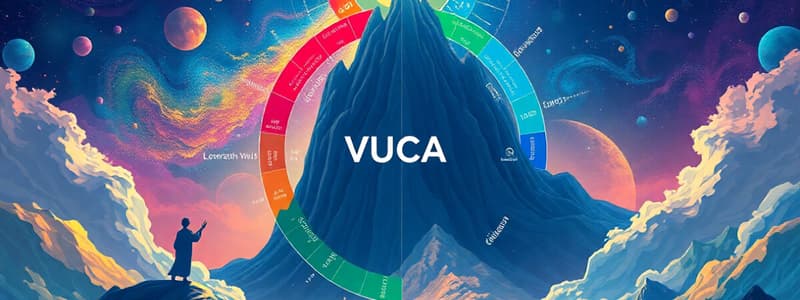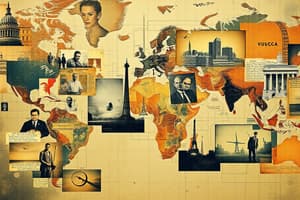Podcast
Questions and Answers
What does the 'V' in the VUCA model represent?
What does the 'V' in the VUCA model represent?
- Validity
- Value
- Volatility (correct)
- Visibility
Which characteristic of the BANI model refers to situations that are hard to comprehend?
Which characteristic of the BANI model refers to situations that are hard to comprehend?
- Incomprehensible (correct)
- Anxious
- Nonlinear
- Brittle
What societal change is influenced by increased disposable incomes?
What societal change is influenced by increased disposable incomes?
- Reduced travel opportunities
- Decreased media influence
- Less leisure time
- Higher ethical scrutiny of practices (correct)
Which component of the VUCA model describes the challenges of making predictions?
Which component of the VUCA model describes the challenges of making predictions?
How does the 'Nonlinear' aspect of the BANI model manifest in real-world scenarios?
How does the 'Nonlinear' aspect of the BANI model manifest in real-world scenarios?
What is the primary focus of Strategic Human Resource Management (SHRM)?
What is the primary focus of Strategic Human Resource Management (SHRM)?
Which of the following is NOT an intended practice in the HRM organization effectiveness model?
Which of the following is NOT an intended practice in the HRM organization effectiveness model?
Why is the perception of practices important in HRM?
Why is the perception of practices important in HRM?
Which aspect of employee attitudes indicates a positive relationship with their employer?
Which aspect of employee attitudes indicates a positive relationship with their employer?
What behavior is associated with discretionary behaviors in an effective HRM system?
What behavior is associated with discretionary behaviors in an effective HRM system?
What contributes to employee engagement in the workplace?
What contributes to employee engagement in the workplace?
Which factor is likely to improve the perceived fairness in the workplace?
Which factor is likely to improve the perceived fairness in the workplace?
How does a high turnover rate affect the labor market in the H&T industry?
How does a high turnover rate affect the labor market in the H&T industry?
What is a primary goal of the recruitment process?
What is a primary goal of the recruitment process?
Which factor has the greatest impact on recruitment success?
Which factor has the greatest impact on recruitment success?
What does good recruitment help to achieve?
What does good recruitment help to achieve?
Which of these is NOT a component that affects the quality of job candidates?
Which of these is NOT a component that affects the quality of job candidates?
What role does management play in recruitment?
What role does management play in recruitment?
Why is alignment with career management important in recruitment?
Why is alignment with career management important in recruitment?
What should a recruitment plan aim to do regarding employee motivation?
What should a recruitment plan aim to do regarding employee motivation?
What should be avoided to reduce internal conflicts during recruitment?
What should be avoided to reduce internal conflicts during recruitment?
What does individual performance consist of according to the simple formula provided?
What does individual performance consist of according to the simple formula provided?
What is a primary disadvantage of workforce planning mentioned?
What is a primary disadvantage of workforce planning mentioned?
Which of the following is a factor that can negatively impact the accuracy of workforce planning?
Which of the following is a factor that can negatively impact the accuracy of workforce planning?
Which HRM practice is NOT mentioned as influencing employee performance?
Which HRM practice is NOT mentioned as influencing employee performance?
What distinguishes development from training?
What distinguishes development from training?
What is the purpose of workforce planning in an organization?
What is the purpose of workforce planning in an organization?
How does workforce planning help build a talent pool?
How does workforce planning help build a talent pool?
Which of the following is an example of a development activity?
Which of the following is an example of a development activity?
What is one way that organizational performance is enhanced?
What is one way that organizational performance is enhanced?
How does learning primarily impact an individual?
How does learning primarily impact an individual?
What is a critical challenge associated with training and development?
What is a critical challenge associated with training and development?
Which of the following is a key point of workforce planning?
Which of the following is a key point of workforce planning?
Which practice is NOT part of Human Resource Development (HRD)?
Which practice is NOT part of Human Resource Development (HRD)?
Why is understanding performance issues important in HRD?
Why is understanding performance issues important in HRD?
What is the primary focus of training in the context of HRD?
What is the primary focus of training in the context of HRD?
What is one of the key outcomes of performance reviews in an organization?
What is one of the key outcomes of performance reviews in an organization?
What is a primary benefit of sustainable tourism for local communities?
What is a primary benefit of sustainable tourism for local communities?
How can sustainable practices attract funding for companies?
How can sustainable practices attract funding for companies?
Which of the following is NOT a key element of sustainable HRM?
Which of the following is NOT a key element of sustainable HRM?
What aspect of sustainable HRM emphasizes fair treatment of employees?
What aspect of sustainable HRM emphasizes fair treatment of employees?
What outcome can sustainable practices have on a company's public image?
What outcome can sustainable practices have on a company's public image?
What does sustainable HRM aim to balance according to Ehnert (2009)?
What does sustainable HRM aim to balance according to Ehnert (2009)?
Which benefit of sustainability relates to improved efficiency?
Which benefit of sustainability relates to improved efficiency?
In sustainable HRM, what does employee well-being primarily focus on?
In sustainable HRM, what does employee well-being primarily focus on?
Flashcards
VUCA Model
VUCA Model
A model describing the dynamic and unpredictable business environment characterized by volatility (rapid changes), uncertainty (lack of predictability), complexity (multiple interconnected forces), and ambiguity ( unclear cause-and-effect relationships).
BANI Model
BANI Model
This model describes the modern business environment as brittle (fragile and susceptible to collapse), anxious (stressful due to uncertainty), non-linear (unpredictable outcomes from small actions), and incomprehensible (difficult to understand due to complexity).
Increased Disposable Incomes
Increased Disposable Incomes
The increasing availability of financial resources for leisure activities, leading to more travel and discretionary spending.
Increased Population Longevity
Increased Population Longevity
Signup and view all the flashcards
Higher Demand for Competencies
Higher Demand for Competencies
Signup and view all the flashcards
HRM
HRM
Signup and view all the flashcards
SHRM
SHRM
Signup and view all the flashcards
Intended Practices
Intended Practices
Signup and view all the flashcards
Actual Practices
Actual Practices
Signup and view all the flashcards
Perceived Practices
Perceived Practices
Signup and view all the flashcards
Employee Attitudes
Employee Attitudes
Signup and view all the flashcards
Employee Behavior
Employee Behavior
Signup and view all the flashcards
Discretionary Behaviors
Discretionary Behaviors
Signup and view all the flashcards
Recruitment
Recruitment
Signup and view all the flashcards
Employer Branding
Employer Branding
Signup and view all the flashcards
Influencing Factors in Recruitment
Influencing Factors in Recruitment
Signup and view all the flashcards
High-Quality Candidates
High-Quality Candidates
Signup and view all the flashcards
Desired Outcomes of Recruitment
Desired Outcomes of Recruitment
Signup and view all the flashcards
Job and Organization Attraction
Job and Organization Attraction
Signup and view all the flashcards
Increase Employee Motivation (Recruitment Plan)
Increase Employee Motivation (Recruitment Plan)
Signup and view all the flashcards
Reduce Financial Costs (Recruitment Plan)
Reduce Financial Costs (Recruitment Plan)
Signup and view all the flashcards
Workforce Planning
Workforce Planning
Signup and view all the flashcards
Attendance
Attendance
Signup and view all the flashcards
Turnover
Turnover
Signup and view all the flashcards
Onboarding
Onboarding
Signup and view all the flashcards
Organizational Performance
Organizational Performance
Signup and view all the flashcards
Individual Performance Formula
Individual Performance Formula
Signup and view all the flashcards
Feedback Loop
Feedback Loop
Signup and view all the flashcards
Job Design
Job Design
Signup and view all the flashcards
Training
Training
Signup and view all the flashcards
Learning
Learning
Signup and view all the flashcards
Development
Development
Signup and view all the flashcards
Human Resources Development (HRD)
Human Resources Development (HRD)
Signup and view all the flashcards
Training & Development
Training & Development
Signup and view all the flashcards
Career Development
Career Development
Signup and view all the flashcards
Strategy Link
Strategy Link
Signup and view all the flashcards
Clear Needs
Clear Needs
Signup and view all the flashcards
Sustainable Tourism
Sustainable Tourism
Signup and view all the flashcards
Benefits of Sustainable Tourism for Businesses
Benefits of Sustainable Tourism for Businesses
Signup and view all the flashcards
Sustainable Human Resource Management (HRM)
Sustainable Human Resource Management (HRM)
Signup and view all the flashcards
Justice and Equality in Sustainable HRM
Justice and Equality in Sustainable HRM
Signup and view all the flashcards
Transparent HR Practices in Sustainable HRM
Transparent HR Practices in Sustainable HRM
Signup and view all the flashcards
Profitability in Sustainable HRM
Profitability in Sustainable HRM
Signup and view all the flashcards
Employee Well-being in Sustainable HRM
Employee Well-being in Sustainable HRM
Signup and view all the flashcards
Why Sustainable HRM Matters for Businesses
Why Sustainable HRM Matters for Businesses
Signup and view all the flashcards
Study Notes
Hospitality HRM Overview
- Current hospitality industry context is presented
- VUCA and BANI models are discussed
- Impact of tourism changes on the workplace is detailed
- HRM policies and practices are outlined
VUCA Model
- V: Volatility - rapid and unpredictable changes
- U: Uncertainty - inability to predict future events
- C: Complexity - interconnectedness of factors
- A: Ambiguity - difficulty in understanding cause-and-effect relationships
BANI Model
- B: Brittle - seemingly strong but easily broken
- A: Anxious - feeling stressed and worried due to uncertainty
- N: Nonlinear - small actions can lead to large consequences
- I: Incomprehensible - difficulties understanding complex situations
Societal Changes
- Increased disposable incomes and leisure time
- Increased population longevity and travel opportunities
- Globalized free market and competition
- Higher ethical scrutiny of companies
- Increased stakeholder expectations
- Knowledge-based workforce and technological innovation
- Demographic changes
HRM - Organization Effectiveness Model
- HRM influences organizational effectiveness
- Intended practices (Ability, Motivation, Opportunity) impact actual practices by managers
- Perceived practices (Psychological contract, trust, fairness) affect employee attitudes.
- Employee attitudes (Commitment, satisfaction, engagement) influence behavior.
- Employee behavior (OCBs, turnover, attendance) and organizational performance are linked.
- A feedback loop continuously improves HRM practices.
Workforce Planning
- Ensures the right number of people with the right skills for future needs.
- Involves reviewing job roles for accuracy and market trends
- Evaluates the labor market to determine future staffing needs
Job Design Concept
- Balancing stakeholder expectations (customers, society, colleagues, employers, employees).
- Customer expectations (product delivered promptly and well).
- Society's expectations (fairness and ethical practices).
- Colleague's expectations (good teamwork and mutual support).
- Employer expectations(productivity and meeting goals).
- Employee expectations (fair pay, respect, and an environment).
Job Analysis
- Identifying the duties, skills, and knowledge needed for a job.
- Supporting hiring, training, and performance evaluations.
- Ensuring job descriptions accurately reflect the position.
- Using methods like observation, interviews, and surveys.
Hiring and Recruitment
- Finding and hiring the best talent
- Reflecting the company's values and mission
- Key components include influencing factors, quality of candidates, and desired outcomes.
- Recruiting is a process for attracting qualified candidates.
- Factors such as employer brand, manager quality, workplace attributes, and job characteristics influence candidate appeal.
Recruitment Sources
- Variety of methods for attracting potential candidates (Internet, consultants, academia, institutions).
- This section highlights the different methods for sourcing and recruiting talent.
Training, Learning, and Development
- Training focuses on improving current job skills
- Learning involves acquiring new knowledge and understanding
- Development focuses on future job skills and growth opportunities
HRD (Human Resource Development) Challenges
- Link training to company goals
- Clearly define required skills
- Effective implementation of training programs
- Adaptation to changing business needs
- Addressing performance issues in training
- Addressing logistical and resource concerns in planning and delivering training
Performance Gaps and Training Processes
- Comparing predicted and actual performance
- Causes of performance gaps in training and support
- Methods to evaluate a person's performance
- Methods for designing, delivering, and evaluating training programs
Rewards and Motivation
- Extrinsic rewards (external, Financial, Non-Financial)
- Intrinsic rewards (internal)
- Performance related rewards (performance linked rewards)
- Importance of aligning rewards with company needs
- Understanding expectancy theory to motivate employees.
Job Evaluation
- Method for determining the value of different jobs within an organization.
- Importance of job analysis for creating a fair and efficient pay structure.
- Different approaches to job evaluation are examined.
Diversity, Inclusion, and Corporate Sustainability
- Importance of social identity theory (SIT) to understand group dynamics
- Importance of inclusion in workplaces
- Challenges like explicit/implicit bias, employee self-selection, diversity initiatives, work-life balance.
- Overview of corporate sustainability and social responsibility
Wellbeing and Work-Life Balance
- Understanding aspects of wellbeing
- Various perspectives on wellbeing
- Importance of wellbeing in the workplace
- Strategies to improve work-life balance for employees
- Understanding workplace issues that may impact wellbeing
Studying That Suits You
Use AI to generate personalized quizzes and flashcards to suit your learning preferences.




